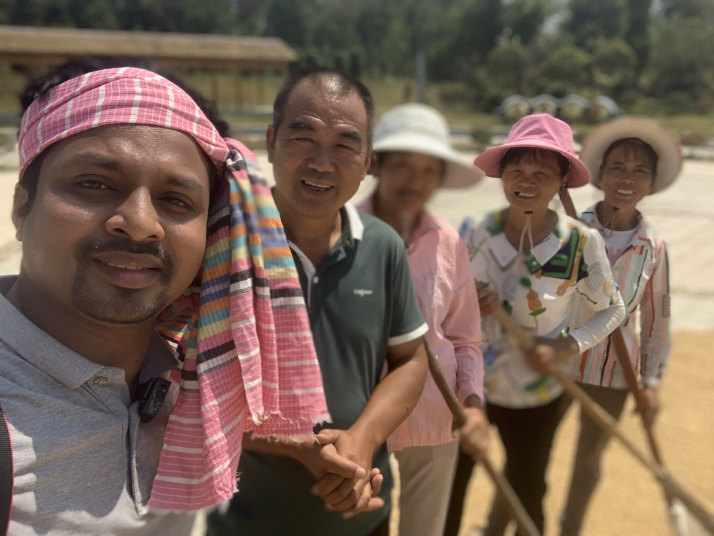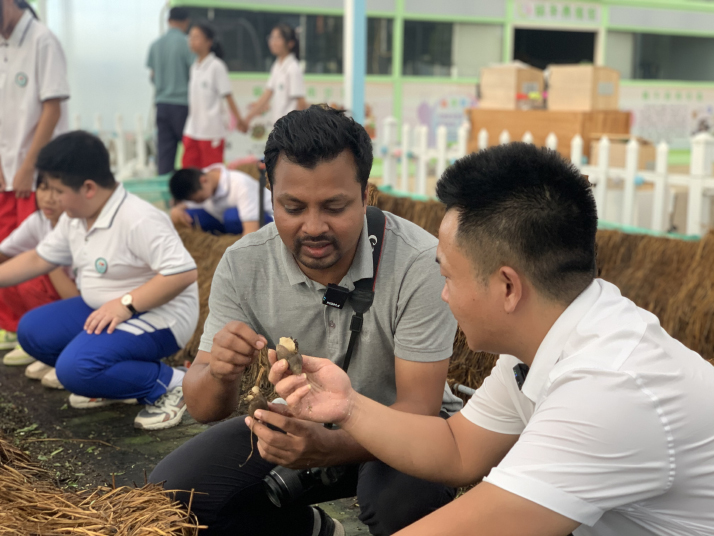| Voice |
| How one tiny town created a unique recipe for China's rural development | |
|
|
 Islam is in the field drying beans with producers and farmers in Liufang on September 12, 2022 (COURTESY PHOTO)
Sitting under the glaring spotlight, Gong Xinsun, Secretary of the Communist Party of China (CPC) Liufang Township Committee in east China's Jiangxi Province, waved at the camera as he launched into a six-hour-long e-commerce live-streaming marathon to sell bean-made products. Gong and his two co-hosts talked nonstop, yelling "Buy it now!" all night long. They raked in 1,000 orders, a solid outcome. This tiny snippet from Liufang, Hukou County of Jiujiang City, where people's lives center on several kinds of beans—from growing to processing and selling them, exemplifies the bigger picture of China's rural revitalization strategy, which makes e-commerce undertakings, like the one in Liufang, possible. At the 19th CPC National Congress in October 2017, President Xi Jinping proposed the country's rural revitalization strategy, with the general requirements of achieving thriving businesses, pleasant living environments, social etiquette and civility, effective governance and prosperity in rural areas. Among these, industrial takeoff remains the top priority as it is the basis for increasing farmer incomes, agricultural development and rural prosperity. In recent years, China has continuously implemented policies and projects to support the development of rural industries. In Liufang, rural revitalization strides forward by relying on a small bean which today even becomes a dish on an overseas dinner table. A single bean can produce hundreds of delicacies—and an entire industry. For this township, the bean is the "password" for rural revitalization.  Bangladeshi journalist and scholar Mohammad Saiyedul Islam talks with a local resident over bean residue and powder in Liufang Township, Jiangxi Province, on September 12, 2022 (COURTESY PHOTO)
Making moves As China's only Bean Fragrance Town and one of its origins of bean cultivation, Liufang had long wanted to develop and flourish. But the question was always: how? Liufang has a special geographical position where the Yangtze River, the longest river not only in China but also in Asia, and Poyang Lake, China's largest freshwater lake, converge. And so, Liufang in recent years decided to make full use of its advantageous resources, accelerating the pace of its development of modern agriculture with local characteristics, striving to form a modern agricultural development pattern, and promoting the effective connection between the achievements of China's poverty alleviation campaign, which saw the eradication of absolute poverty nationwide in late 2020, and rural revitalization. Liufang took the bean industry as its leading asset and transformed it into a high-quality industry. Liufang insisted on making every effort to create a unique bean industry ecosystem. The township's Bean Culture Industrial Park, for example, is an innovative, entrepreneurial, cultural, agricultural, and tourism demonstration industrial park. The Cultural Industrial Park project in Liufang, then, has a total investment of $74 million and started construction in 2019, integrating a bean culture experimental planting area, a business and trade area, an ecological landscape area, a bean culture tourism service area, plus a scientific research and processing area. Making money The process of rural revitalization is largely a market-oriented industrial transformation and upgrading process with technology and innovation as the basic driving forces. Modern agricultural production is no longer based on quantity but must focus on high-quality and green efficiency. While protecting traditional agricultural production, it is necessary to vigorously introduce modern production factors to ensure national food security and realize agricultural modernization. Xu Yu, one of the large-scale bean producers in Liufang, said by getting help from the industrial park, he can sell the beans at a good price, and also create byproducts by turning his produce into soybean sauce, wine, cakes, and more. Fifty-year-old Liu Juan, who leads the workforce at Fangzhou Ecological Agriculture Co. Ltd., said she has been working in this factory since the company first started out in 2018. As a local, it takes her less than 10 minutes to get home on her electric scooter. At noon, she can go home to cook for her husband, who is in poor health. Liu earns more than $295 a month, more than what she made at her previous job, but the most important thing is that she can look after her family. Liu Xiafeng works as a technical supervisor at Fangde Food Technology Co. Ltd. in the industrial park. She used to be a migrant worker, seeking employment in other provinces, and would only return to Liufang twice a year, once during the Spring Festival holiday and once during her children's school summer holidays. Now, her local employment sees her earn enough to support her family—and be with them every day. With a basic salary of $442 per month, she can make more than $590 on average per month. According to Luo Deming, Board Chairman of Fangde Food Technology, the company officially went into operation in November 2022, and its sales in 2023 are estimated to exceed $1.5 million. The company's bean products have traversed the open waters to Australia and Arabic countries. Both the bean residue and powder can be recycled and reused as processing byproducts, for example serving as land snail food or as a substrate in mushroom cultivation, Luo said. Then there's the Liufang Bean Workshop, gathering bean farmers from the township itself as well as the surrounding area, which develops bean products such as whitebait sauce, fried tofu puff sauce, shrimp sauce, bean wine and bean paste. These products are sold in shopping malls and supermarkets nationwide. Sitting on the bank of Poyang Lake, the workshop is surrounded by trees, maintaining the site's original ecology, and neighbors the industrial park. Walking into the bean wine shop, the air is filled with a strong aroma. The wine is mainly made of glutinous rice, sorghum, and mung bean, and divided into three types such as high, medium and low alcohol content. The story of Liufang is like that of Jack and the Beanstalk, seeing the township truly taking advantage of the opportunities that life provides—however small they may appear. The efforts of the township's locals in taking their main product, a tiny bean, and using it to give their lives a complete overhaul has impressed and motivated developing countries like Bangladesh. And Liufang is just a snapshot of the progress occurring across thousands of townships in China. In Bangladesh, over 50 percent of the country's workforce is engaged in agricultural production and so Liufang's experience in industrial revitalization can prove enlightening. Its small bean has created a "unique recipe" for China's development. The author is a Bangladeshi journalist and a doctoral fellow with the School of International Trade and Economics under the Jiangxi University of Finance and Economics Printed edition title:Keen as a Bean Copyedited by Elsbeth van Paridon Comments to liwenhan@cicgamericas.com |
|
||||||||||||||||||||||||||||
|